Explore the differences between contract and permanent employment, including pros, cons, and how to choose the right model for your business goals.
Now, more than ever, having reliable recruitment agents on your side will help you navigate uncertainties in a constantly evolving world.
The right talent partner brings their years of industry expertise to help you optimize your HR strategies.
Resume Tips From a Professional Recruiter
If you are thinking about a job change, consider some resume tips from a professional recruiter. Putting yourself out there on the job market can be challenging. It requires patience, determination, and some humility. Submitting job applications can often put you in a vulnerable place, and no one likes rejection. So there is little point in going about something as hard as a job search ill-prepared. How, one may ask, should someone prepare for a job search? The answer should be at the forefront of your mind, not only during job searches but in your professional career too. A quality resume is powerful. When organized well and executed correctly, a resume can make a job search easy. If a resume is constructed poorly, however, it can be to your detriment. With recruiting and hiring almost exclusively online nowadays, maximizing your digital resume is more important than ever. This article will go over some resume tips that will help you stand out to recruiters.Basic Resume Advice
A good resume is not easy to come by. Too many people just slap their work experience into a word document and call it good. Not surprisingly, that is a waste of time. So much more is needed to show off your achievements and skills. There are reasons that simply listing skills and work experience however you please isn’t efficient. When you submit a job application, your resume is going to be one of the first things a recruiter will see. Recruiters are usually trained to look for specific things in a resume. If what they are looking for isn’t found quickly, there is a chance your application could be discarded. Of course, there are some basic rules to follow when putting together a resume that will help you get noticed. Listed below are some helpful resume tips from a professional recruiter:Watch the Format
Keep your resume looking nice. It shows professionalism, attention to detail, and that you are interested in working. A polished format will help with the overall look of the resume.. Remember to keep formatting clean-looking, fonts and font sizes legible, and spacing consistent. You can inject personality with splashes of color or unusual headings. Don’t get too carried away though, and don’t include a head shot, or else it might start to look too unprofessional. Consider looking into templates if you need help. Always keep it to one page. Unless you are applying to a big-time executive position, don’t let any information run onto a second page.Brag and Boast
If you only have one take-away from this article on resume advice, remember this: your resume is your highlight-reel. It is a ticket to brag about your accomplishments and your skills. Don’t be shy! Mention job titles, awards, honors, and any other kind of things you feel deserve mentioning. Of course, try to keep it relevant and keep it honest. Don’t exaggerate to make yourself look good. Honesty goes a long way, but recruiters really want to see what you can do.Limit Content if Necessary
While you should brag about your accomplishments, it is not necessary to list everything you have ever done. Putting down all the jobs you have had since high school will only take up precious space. Instead, consider what is most relevant and what will really help get you the job you want. It is important to limit some content to make way for really important information. The important information will vary depending on the job, so it will require some judgment calls on your part.Edit Vigorously
Among all the resume tips from a professional recruiter, this may be one of the most important. Pretend that your resume is an editing assignment for grammar class. A great deal of effort should go into checking grammar, spelling, tense, and pronouns. Some recruiters may immediately discard a resume if they find spelling or grammar errors. A resume free of spelling and grammar errors shows attention to detail and will give you a good advantage. So break out the dictionary and give yourself a refresher on the Oxford comma.What is a Recruiter, and How Can You Stand Out to Them?
What is a recruiter, what do they do, and how can you impress them? Picture a college sports team. They send recruiters around the country to scout out talent and recruit athletes that will fit well in the organization. When a good candidate is found, they will try to get their attention and convince them to join their organization. It’s an interesting reversal. Athletic recruiters try to get candidates’ attention while corporate and agency recruiters’ attention is often sought by candidates. So it is your duty, as a job-seeker, to capture the attention of a recruiter. Of course, some may reach out to you through job search apps. You may need to decide if they are worth speaking with. How do you catch the attention of the good recruiters? It helps to know what their job is. They go through many resumes and applications, sometimes dozens at a time. They need to make sure an applicant is qualified and is a good fit for the position and company. They need to be careful about who they select and who they spend time getting to know, as they have to vouch for you when they bring your file to a hiring manager. Thus, it is not their job to do you any favors. So to stand out to a recruiter, you need to make their job easier. Make yourself worth recommending. Project a confident and professional tone. Make sure your writing is free of errors and that your resume is relevant to the position. If you help the recruiter, you are sure to stand out. And of course, unless directed otherwise, a cover letter never hurts.How to Send a Resume to a Recruiter
Personalization is the name of the game when it comes to sending a resume to a recruiter. Remember that you want to stand out while also making the recruiter’s job easier. By emailing your resume and cover letter directly to the recruiter, you are sure to stand out. Following the tips previously mentioned will also help with standing out. Keep the body of the email short and professional and avoid cliches. Include a strong subject line. You can usually find a good email on the company website. If an email to a recruiter or hiring manager can’t be found, you can usually find a generic email. Just include in the body or the subject something regarding the concerned department.A Quality Resume is Key
Taking the time to polish your resume might very well land you that job. Leaving it in a poor state, however qualified you may be, may cost you the job. A lot of business is done online now, and recruiting is no exception. Because of that fact, resume construction is everything. It tells a recruiter who you are and what you are capable of. It is their only reference of what kind of person and worker you are. Use these resume tips from a professional recruiter and build your resume to make it represent you properly. If you feel your resume is ready, submit it here to be considered for any openings you may be qualified for in your general location. It may be nerve-racking, but adequate preparation will lend great confidence.let’s talk
SEND US A MESSAGE
"*" indicates required fields
The Biggest Job Search Mistakes and How to Fix Them
Job hunting is a stressful time. We have all been there: in the hunt for a new job and completely bungling it due to the stress and inexperience. Many of us only change jobs a few times in our lifetime, and so much can change in between each job search. We will tell you the biggest job search mistakes and how to fix them. Trust the talent experts at Brightwing to help you avoid the biggest job search mistakes.The Biggest Job Search Mistakes and How to Fix Them
To prepare you for your next job search, the talent experts at Brightwing have compiled this list of the biggest job search mistakes — and how you can fix each one.Using the “Best Job Search Apps”
Many job seekers rely entirely on job board websites like LinkedIn and Indeed. While there is nothing wrong with using these resources, especially as a starting-off point for your job search, there are better ways of finding the right job for you. Even the best job search apps are just that: apps. Apps cannot compare with people. A job recruiter gets to know you in a way that an app or website never can. Plus, these apps are full of thousands of jobs. It is virtually impossible to narrow it down to the one job that is a great fit for you. It is extremely unproductive to sit and scroll through jobs for hours on end, especially if you are still working a job while undergoing your hunt for your next one.Not Applying Due to Job Search Requirements
Many applicants don’t apply to jobs unless they meet 100% of the requirements laid out in the job listing. Here is a little secret: you don’t have to meet all the job requirements in order to apply. Men tend to apply for jobs when they only meet 60% of the qualifications, but many women tend only to apply if they meet 100% of the listed requirements. Don’t be afraid to apply for that job if you only have two years of experience instead of three, or your degree isn’t the same that is specified.Lying About Your Skills
Now, just because you don’t meet the job search requirements doesn’t mean you should lie to meet them. Instead, explain to the company why you are still a fabulous fit for their position, and demonstrate your ability to learn new skills that would help you excel. Never, ever lie in order to land a job.Relying On Outdated Job Search Strategies
If it has been five, ten, fifteen years (or more!) since you have last been on the job hunt, the tactics for securing your next position have most likely changed. Make sure to do your research on the best job search tips, or even better, work with a recruiter who knows the latest strategies for landing the next position in your dream career.Underestimating Your Worth
Even when the job market is tough, never underestimate your own worth and potential. All too often, job seekers accept the first offer they receive. Make sure you know how much your individual skills and experience are worth. A recruiter can help you find positions that you might not even realize you are qualified for!Not Working With a Recruiter
Especially if you work in a specialized industry like finance, IT, or engineering, it is best to work with a recruiter to find the right job for you. These types of companies typically work with an agency like Brightwing to fill their positions, and this will give you a leg up during your search.The Best Job Search Tips
As talent experts, we know a thing or two about the job search. These are the best job search tips from the professionals:Work With a Recruiting Agency
Searching for your next full-time job can oftentimes feel, well, like a full-time job. And at Brightwing, it is our full-time job: to help you find the right role, team, and company. That is what makes working with a recruiting company worthwhile. Working with Brightwing takes all the stress out of the job hunt.Know What You Want
Before you begin your job hunt, make sure you know what you are looking for in your next role and workplace. What type of position are you looking for? What is your ideal salary? Do you want to take on more responsibility at your next job? What type of company culture do you prefer? Knowing the answers to all of these questions can help your recruiter find the best fit for you.Don’t Limit Yourself to Online Applications
All too often, job seekers apply for jobs online, and never hear back — even if they are ideal for the position. Online applications have a way of getting lost in the shuffle. Many employers rely on referrals and recruiting agencies to fill jobs, which means your resume might not even garner a glance. When you work with a talent expert, they will advocate for you for the position that they know you are right for.Be Prepared
If you want to ace your next job interview, be prepared. The number one mistake that job seekers make during the recruitment process is under preparing for their interviews. Make sure to do your research into the company you are interviewing with, and the interviewer if possible, and to show up prepared with examples of your work on hand. Employers not only want to hear about you and your experience, but they also want to know what you like about their company, why you want to work for them, and why you will be a great fit.Enjoy the Job Search and Avoid Mistakes with Brightwing
Now, you know the biggest job search mistakes and how to fix them. If you want to find the right job and avoid making any mistakes in the process, consider working with Brightwing Talent Experts. Our company was recently named Great Recruiters Certified for the second consecutive year in recognition of creating a top-ranked candidate experience. Contact us today so we can get to know you better.let’s talk
SEND US A MESSAGE
"*" indicates required fields
There’s fierce competition for employees in the automotive supplier business, but this industry is booming with great jobs of all ranges.
Learning the different types of interviews and how to prepare for them can help you land your desired position.
How to Find Great Employees for Your Engineering Team
Creating an effective engineering team is all about choosing the right members. Just like any job, who you work with makes a huge difference. Engineering is a field where the engineering talent of your team can affect every aspect of your growth, output, and production. Finding the right candidates to join your engineering team takes time and effort, but it is definitely worth it to find the right person. This is why most engineering companies use experienced recruiters like Brightwing to bring the talent to them.Attracting Engineering Talent in 2022
Building a team of talent in 2022 can be difficult in some ways and easy in others. In 2021, millions of Americans quit their jobs in search of new opportunities. At this point, there is a large gap in opportunities vs. candidates, which means that the job market for hiring is competitive; however, there are a lot of good candidates to be found. Creating a solid team in 2022 is very possible as a lot of people have left their jobs even after years of working for their prior companies. Finding experienced workers and newly graduated students alike is relatively easy, but attracting them to your engineering firm may be a little easier said than done.Job Offers
Creating a unique job offer to appeal to engineering talent is essential in today’s hiring scene. What does a unique job offer look like? There are a few ways to make your offer the best one on the table:Competitive Salary
Obviously offering a competitive wage is important, but including things like bonuses and room for pay raises and growth will help you stand out among the crowd. Millennials especially tend to take a job that will promise them a career path and scheduled raises rather than a high-paying job where they can’t grow. Offer salary vs. hourly, whatever may work best for you. A competitively priced job offer isn’t just important in this market, it is absolutely essential.Benefits
Offering benefits will help your employees know that you care about their health and welfare. Most large firms are offering benefits like health insurance, dental and vision, and 401ks. Make an effort to offer a benefits package that will be interesting and worth it to your new hires. If you offer a plan that doesn’t cover the basics or has an extremely high deductible, that detracts from your offer. Employee benefits are also tax-free to employers, which can help your business in return.Perks
Fun, exciting perks don’t always have to be fancy or over-the-top. You can offer monthly competitions with modest prizes. Have casual Fridays! Have special gifts for birthdays! Find a way to bring something you enjoy into the workplace, like offering a gym membership to each employee or renting out a theater twice a year for a premiere. Sometimes something simple and enjoyable can make your job stand out over another and often turn the tide for an employee trying to decide between two firms.Show them Your Spark
Help people know that you offer a problem to be solved or a challenge to face in your field. Show your engineering team that you work on something worthwhile and interesting! Engineering is sometimes seen as boring or stagnant. When you have a project that piques the interest of your candidates, you have a great reason for them to choose you over a firm that just isn’t as interesting. If you specialize in something, tell your applicants. Show them what they would miss out on if they didn’t take your offer!Building a Team of Talent
Creating an engineering team doesn’t mean just finding one good individual and building a team around them, it has to do with recruiting members that will work together as a whole. What makes a good team player in an engineering team?Team Players are Leaders
On some engineering teams, younger or less experienced engineers may feel left out or like they can’t make comments, offer criticism, or otherwise contribute beyond expectations. When teams have rigid hierarchies, non-team leads or juniors may self-censor. You certainly don’t want that – you want a team where everyone can rise to the occasion as both formal and informal leaders. Creating a team of leaders helps people to take charge and work together.How to Find the Perfect Match
Many engineering firms have a difficult time finding the engineering talent they are looking for to fill their teams. Engineers are busy and work on many different kinds of projects, and each firm may experience something different when hiring. Using a recruitment agency for engineering hires is a great way to go about building a team of talent. A renowned recruitment agency with a long-standing engineering focus like Brightwing attracts engineering talent along with other workers in design and manufacturing. Recruiting takes significant time and effort, especially when the recruiting process is optimized to get to know each applicant’s goals, strengths, and weaknesses.Easier for Employers
Creating a team has a lot to do with knowing each member, and it’s hard to go about building a team of talent if you don’t know the talents involved. Self-assessment is notoriously inaccurate, and worse, not everyone is completely honest on their resume. If someone says they are organized and collaborative but they really aren’t, it can have a ripple effect that interferes with your projects, timelines, and budgets. Using an engineering-focused recruiting agency to build engineering teams will save time, money and energy for employers because recruiters are experts at bringing engineers’ true soft and technical skills to light.let’s talk
SEND US A MESSAGE
"*" indicates required fields
Is Job Tenure Actually Hurting Your Career?
One of the hallmarks of a great professional is their ability to divide loyalties. While you should have some loyalty to your employer, you also have a responsibility to yourself. If you don’t own your own professional development, no one else will do it for you. So while your loyalty to your employer may prompt you to stay in a job over the long haul, it’s important to seriously consider what this means to your career long-term. When many recruiters and hiring managers look at lengthy tenures, it can give them the sense that:- You aren’t motivated or driven to achieve
- You’re too comfortable with the familiar and unable to adapt to a new job, leadership style, or corporate culture
- You don’t have a diverse enough skill set to thrive in a modern company and economy, simply because employees gain perspective about best practices as they move from one company to another
How Long Should You Stay at a Job?
So that leads us to the million dollar question: how long should you stay at a job? According to 2018 data from the Bureau of Labor Statistics, here are some of the most common trends:- Workers in management, professional, and related occupations had a median tenure of 5.0 years
- 22% of workers had tenure of 1 year or less
- Younger workers were more likely to have a short tenure than older ones; only 9 percent of workers aged 55 to 74 had a tenure of less than 12 months
- Median tenure for employees aged 55 to 64 (10.1 years) was more than three times that of workers aged 25 to 34 (2.8 years)
3 Signs You’ve Stayed in a Job Too Long
Not every problem can be solved with a job switch. Sometimes you need to stick it out and take advantage of all the opportunities that you have in your current organization before moving on. But staying in a job isn’t always the solution either. There are many good reasons why you should move on to another organization or role. If any of the following red flags pop up, that’s a good sign that it’s time to think about a change.1. Your job no longer challenges you.
If you end the day with time to spare, that means that you’ve almost certainly mastered your current responsibilities. While it’s great to be confident and knowledgeable, staying there won’t help you grow.2. There’s no risk associated with your job.
No one likes being on the boss’s bad side. But if you find that you can make a mistake without consequences, odds are that you either are too good at your job, or you’re working for an organization that doesn’t value growth and excellence. Either way, remaining in those environments will cause you to stagnate.3. It’s hard to justify sticking around.
Health insurance, vacation, and retirement contributions are all important benefits, but they shouldn’t be the sole reason you stick with a job. Other companies offer those same benefits, and they may be able to give you a job that challenges and fulfills you.Final Thoughts: Is it Time for a New Job?
If you’re wondering whether you should consider a new job, you’re certainly not alone. The market is filled with people who are looking to improve their situation. There’s a good chance that you should join them. Our recruiters have placed thousands of candidates in great-fit jobs & contractor roles. We would love to help you find your next best opportunity. Click here to get in touch with a Brightwing recruiter.let’s talk
SEND US A MESSAGE
"*" indicates required fields
contact us:
"*" indicates required fields
1. How to beat the competition when the clock is ticking for in-demand talent…
“Earlier this year, I worked with a client whose hiring process unfolded SO WELL that I need to call it out. A software engineering manager from a major tier 1 auto supplier reached out to me about a candidate I’d posted about on LinkedIn. She took my call even though she was in China on business. → #1: she didn’t sleep on good talent (literally!) Turns out the candidate had another offer on the table, but wasn’t 100% sold. So, the hiring manager had one shot. I gave her some guidance: 1) Gather every decision maker including HR, and let’s get everything done in a single interview; 2) Move fast!! The next day, they bring in our candidate to meet with all stakeholders in a single interview. → #2: they adapted the hiring process to match the urgency of the situation. After the interview, they made their decision quickly. The candidate had an offer in-hand (for exactly what he was asking for) by the end of the following day. → #3: They took decisive, quick action! The client’s flexibility, speed and fair offer landed them an A+ candidate who is currently thriving within their organization. That’s how hiring should work…every time.” – Steve Ermak, Engineering Talent Consultant2. How to qualify client needs properly to land the talent who fits best…
“I was recently in discussions with a VP of Finance about her hiring needs for the coming year. Problem was, I’d heard whispers about the company’s bad reputation. And bad reputations are problematic on a bunch of levels. But whispers are one thing, and first-hand knowledge is another. So I go out to meet the team in person. Why? We need to learn about the culture, the day-to-day atmosphere, in person. We need to meet the people that our candidates could potentially be working for… 1 – to weed out the opportunities that we wouldn’t feel good about matching candidates with 2 – to understand the environment so we can qualify the candidates who’d thrive there 3 – to be able to pitch the company well to candidates. Turns out – the bad reputation was based on a misperception about their industry. The more I talked to them, the more excited I got about their mission. They were doing something valuable and didn’t deserve the bad rap at all. Digging deeper not only let me find a client worth partnering with – but it also put me in a great position to get candidates as excited about the opportunity as I was. Goes to show: qualifying with the intention of DISqualifying can lead to surprising – and great – results.” – Joe Dombles, Finance & Accounting Talent Consultant3. How to use “working interviews” after proper qualification of both the client and candidate…
” ‘I need a bookkeeper yesterday.’ I had a client in a tough situation. The bookkeeper put in her 2 weeks’ notice. He really wanted to find a replacement before she left so they could get some training. The office couldn’t manage without a bookkeeper for any extended period of time. Enter: the working interview. Because of the crazy time crunch, we sent a candidate we were super confident about to work for a day at the office. The candidate had the time & was excited: career change is a big deal. Spending time with your new potential team is a great way to know whether it’s a good move. The client was happy to give it a shot: if it worked out, problem solved! If not, the risk was ours – Brightwing would pay for the day. A day after the working interview, I got some seriously happy messages from the client & candidate. They’d decided to take the leap together and make it official. Not the answer for every situation, but in the right circumstances, working interviews are a very effective way to make a decision for everyone involved. – Dan Start, Finance & Accounting Talent Consultantlet’s get to know each other
SEND US A MESSAGE
"*" indicates required fields
To maximize offer acceptance, you’ve got to help candidates imagine a future where they love working for you and with you. Here are 5 keys to making it nearly impossible to turn down your offer…
A job seeker’s first impressions of your company will make or break their decision to accept a job offer — or to even apply to an opening at your company.
Brightwing recently invited its talent network to participate in a survey to gain an inside perspective of the candidate market.
The core trends influencing the marketing industry are simultaneously changing the hiring profile of the best marketing talent.
The engineering and manufacturing talent shortage isn’t just a buzzword. Its impact is both global and local. Read on to dig into the shortage.
While money isn’t the only way to recruit and retain talent, it’s a massive motivator. Stay current with the market with our 2019 IT salary guide.
Contents
- A Quick Glance at the 2019 Labor Market
- A New Focus for the Future of Hiring
- Hiring Insights in Marketing
- 2019 from the Perspective of Key Leaders
A Glance at the 2019 Labor Market
 The national unemployment rate is at a record low since 1969 and is even lower in many industry sectors and regional markets.
The national unemployment rate is at a record low since 1969 and is even lower in many industry sectors and regional markets.
 This is a typical increase in wages, only 0.1% higher than 2018, which implies stagnant wage growth.
However, job switchers in marketing can expect a 9.1% wage increase – a highly attractive reason to seek something new.
[vc_empty_space]
This is a typical increase in wages, only 0.1% higher than 2018, which implies stagnant wage growth.
However, job switchers in marketing can expect a 9.1% wage increase – a highly attractive reason to seek something new.
[vc_empty_space]
 25.7% of employees are actively seeking new job opportunities.
And 55.5% are passively open to new job opportunities.
25.7% of employees are actively seeking new job opportunities.
And 55.5% are passively open to new job opportunities.
Best cities for jobs
Glassdoor ranks these cities based on hiring opportunity, cost of living, and overall job satisfaction:- Pittsburgh, PA
- St. Louis, MO
- Indianapolis, IN
- Cincinnati, OH
- Hartford, CT
- Boston, MA
- Memphis, TN
- Raleigh, NC
- Cleveland, OH
- Detroit, MI
Top Perks Employers are Highlighting
- Casual dress codes
- Employee discounts
- Remote work opportunities
- Extra paid time off
- Signing bonuses
- Free lunches
- Gym memberships
- Work from home Fridays
- Daycare
A New Focus for the Future of Hiring
In 2018, AI-powered recruitment technologies took off across every industry. Seeking to automate the application, screening, and interviewing processes, these tools unburden the hands, and minds, of recruiters and corporate talent acquisition professionals everywhere. However, our stance on this trend has been, and always will be, that humans are greater than machines – most especially in recruiting for highly skilled Technology, Finance, Engineering and Marketing professionals. Even with a quarter of employees looking for a new job, and over half passively interested should the opportunity present itself, employers cannot rely on the programming of their recruitment technology to make the right matches and entice the best-fit talent. This is the year that employers must focus on the human side of recruitment, specifically, the candidate experience. Here are a few numbers proving why the candidate experience is critical this year: 68% of employees believe the candidate experience is a reflection of the employee experience
68% of employees believe the candidate experience is a reflection of the employee experience
 51% of people continue to look for jobs even after they’ve accepted an offer
51% of people continue to look for jobs even after they’ve accepted an offer
 31% of candidates expect a customized message when a company reaches out with a new opportunity
31% of candidates expect a customized message when a company reaches out with a new opportunity
 55% of applicants give up if they haven’t heard back from a company within two weeks
In short, the role of the candidate experience in your recruitment process cannot be overlooked. One in seven new hires accept a job offer only to walk away at the last minute. Do not let this become your story.
55% of applicants give up if they haven’t heard back from a company within two weeks
In short, the role of the candidate experience in your recruitment process cannot be overlooked. One in seven new hires accept a job offer only to walk away at the last minute. Do not let this become your story.
Quick steps to an awesome candidate experience
- A fast and easy (and mobile-responsive) application process
- Quick feedback and responses to every candidate
- A compelling employer brand that reflects your company culture
- Personalized emails, phone calls, and messages throughout the process
- A short, but thorough, interview process
- A clear understanding of the benefits and perks you offer
- An efficient and valuable onboarding process
Hiring Insights in Marketing
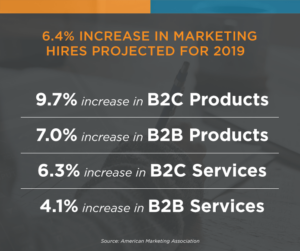 The digital marketing industry, valued at the beginning of 2018 at $192 billion, is expected to grow to $306 billion by 2020. That’s massive, exponential growth, putting the demand for marketers at an all-time high. In fact, marketing manager is the 3rd best job according to Glassdoor, a ranking based on number of job openings, salary, and overall job satisfaction.
That said, marketing is yet another field feeling the pain of a skills gap. CMOs agree that finding marketing talent is one of their biggest challenges in today’s market.
The cherry on top of this talent shortage is that a reported 97% of marketers are open to new opportunities – usually to gain a better salary or career advancement. Although only 19% are actively searching for a new job, this is still massive cause for concern.
The digital marketing industry, valued at the beginning of 2018 at $192 billion, is expected to grow to $306 billion by 2020. That’s massive, exponential growth, putting the demand for marketers at an all-time high. In fact, marketing manager is the 3rd best job according to Glassdoor, a ranking based on number of job openings, salary, and overall job satisfaction.
That said, marketing is yet another field feeling the pain of a skills gap. CMOs agree that finding marketing talent is one of their biggest challenges in today’s market.
The cherry on top of this talent shortage is that a reported 97% of marketers are open to new opportunities – usually to gain a better salary or career advancement. Although only 19% are actively searching for a new job, this is still massive cause for concern.
Top digital marketing trends
- Interactive chatbots
- Voice search
- AI and blockchain
- Influencer marketing
- Security and data privacy
- Personalized messaging
- Data analytics
Most valuable skills when hiring marketing talent
- Creativity
- Natural leadership abilities
- Emotional Intelligence
- Curiosity
- Marketing platform experience
- Data science background
2019 from the Perspective of Key Leaders
 “Low unemployment and increasing skills gaps continue to plague employers who are struggling to fill roles at all levels within their organizations,” said Matt Ferguson, CEO of CareerBuilder. “Fifty percent of U.S. employers reported that it is taking them longer to fill jobs today compared to any other period of time — a trend that is ultimately giving job seekers more leverage.”
“Low unemployment and increasing skills gaps continue to plague employers who are struggling to fill roles at all levels within their organizations,” said Matt Ferguson, CEO of CareerBuilder. “Fifty percent of U.S. employers reported that it is taking them longer to fill jobs today compared to any other period of time — a trend that is ultimately giving job seekers more leverage.”
How Are You Overcoming the Marketing Talent Shortage?
You’re probably gearing up for 2019 hiring, but some of these statistics might be concerning. For us, these statistics are eye-opening. We’re always looking for new ways to partner with companies to overcome these challenges. Our talent acquisition solutions are one-part relationships, one-part insight, and one-part results. It’s a recipe that works every time, and we’d love to introduce you.We want to partner with you. Let’s chat.
Share This Post [social-share] More Like ThisContents
- A Quick Glance at the 2019 Labor Market
- A New Focus for the Future of Hiring
- Hiring Insights in Finance & Accounting
- 2019 from the Perspective of Key Leaders
A Glance at the 2019 Labor Market
 The national unemployment rate is at a record low since 1969 and is even lower in many industry sectors and regional markets.
The national unemployment rate is at a record low since 1969 and is even lower in many industry sectors and regional markets.
 This is a typical increase in wages, only 0.1% higher than 2018, which implies stagnant wage growth.
However, job switchers in finance can expect a 9.4% wage increase – a highly attractive reason to seek something new.
[vc_empty_space]
This is a typical increase in wages, only 0.1% higher than 2018, which implies stagnant wage growth.
However, job switchers in finance can expect a 9.4% wage increase – a highly attractive reason to seek something new.
[vc_empty_space]
 25.7% of employees are actively seeking new job opportunities.
And 55.5% are passively open to new job opportunities.
25.7% of employees are actively seeking new job opportunities.
And 55.5% are passively open to new job opportunities.
Best cities for jobs
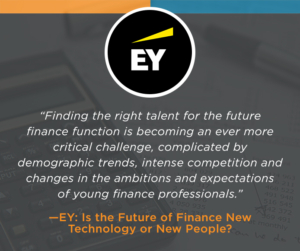 Glassdoor ranks these cities based on hiring opportunity, cost of living, and overall job satisfaction:
Glassdoor ranks these cities based on hiring opportunity, cost of living, and overall job satisfaction:
- Pittsburgh, PA
- St. Louis, MO
- Indianapolis, IN
- Cincinnati, OH
- Hartford, CT
- Boston, MA
- Memphis, TN
- Raleigh, NC
- Cleveland, OH
- Detroit, MI
Top Perks Employers are Highlighting
- Casual dress codes
- Employee discounts
- Remote work opportunities
- Extra paid time off
- Signing bonuses
- Free lunches
- Gym memberships
- Work from home Fridays
- Daycare
A New Focus for the Future of Hiring
In 2018, AI-powered recruitment technologies took off across every industry. Seeking to automate the application, screening, and interviewing processes, these tools unburden the hands, and minds, of recruiters and corporate talent acquisition professionals everywhere. However, our stance on this trend has been, and always will be, that humans are greater than machines – most especially in recruiting for highly skilled Technology, Finance, Engineering and Marketing professionals. Even with a quarter of employees looking for a new job, and over half passively interested should the opportunity present itself, employers cannot rely on the programming of their recruitment technology to make the right matches and entice the best-fit talent. This is the year that employers must focus on the human side of recruitment, specifically, the candidate experience. Here are a few numbers proving why the candidate experience is critical this year: 68% of employees believe the candidate experience is a reflection of the employee experience
68% of employees believe the candidate experience is a reflection of the employee experience
 51% of people continue to look for jobs even after they’ve accepted an offer
51% of people continue to look for jobs even after they’ve accepted an offer
 31% of candidates expect a customized message when a company reaches out with a new opportunity
31% of candidates expect a customized message when a company reaches out with a new opportunity
 55% of applicants give up if they haven’t heard back from a company within two weeks
In short, the role of the candidate experience in your recruitment process cannot be overlooked. One in seven new hires accept a job offer only to walk away at the last minute. Do not let this become your story.
55% of applicants give up if they haven’t heard back from a company within two weeks
In short, the role of the candidate experience in your recruitment process cannot be overlooked. One in seven new hires accept a job offer only to walk away at the last minute. Do not let this become your story.
Quick steps to an awesome candidate experience
- A fast and easy (and mobile-responsive) application process
- Quick feedback and responses to every candidate
- A compelling employer brand that reflects your company culture
- Personalized emails, phone calls, and messages throughout the process
- A short, but thorough, interview process
- A clear understanding of the benefits and perks you offer
- An efficient and valuable onboarding process
Hiring Insights in Accounting & Finance
The finance field is undergoing a transformation due to trends such as:- FinTech
- Cryptocurrency
- Blockchain
- Robotic process automation (RPA)
- Cloud
- Artificial Intelligence
- Cybersecurity
- Regulatory changes
 47% of CFOs believe their teams are too shorthanded to meet future industry demands.
47% of CFOs believe their teams are too shorthanded to meet future industry demands.
 57% say that skills in predictive and prescriptive analytics are crucial for finance and accounting functions of the future.
57% say that skills in predictive and prescriptive analytics are crucial for finance and accounting functions of the future.
773,800 new jobs will be added to the finance and accounting marketplace by 2026.
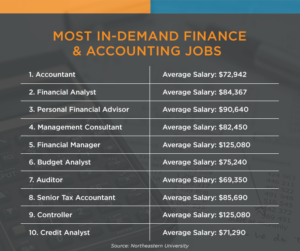
2019 from the Perspective of Key Leaders
 “Low unemployment and increasing skills gaps continue to plague employers who are struggling to fill roles at all levels within their organizations,” said Matt Ferguson, CEO of CareerBuilder. “Fifty percent of U.S. employers reported that it is taking them longer to fill jobs today compared to any other period of time — a trend that is ultimately giving job seekers more leverage.”
“Low unemployment and increasing skills gaps continue to plague employers who are struggling to fill roles at all levels within their organizations,” said Matt Ferguson, CEO of CareerBuilder. “Fifty percent of U.S. employers reported that it is taking them longer to fill jobs today compared to any other period of time — a trend that is ultimately giving job seekers more leverage.”
How Are You Overcoming the Finance & Accounting Talent Shortage?
You’re probably gearing up for 2019 hiring, but some of these statistics might be concerning. For us, these statistics are eye-opening. We’re always looking for new ways to partner with companies to overcome these challenges. Our talent acquisition solutions are one-part relationships, one-part insight, and one-part results. It’s a recipe that works every time, and we’d love to introduce you.We want to partner with you. Let’s chat.
Share This Post [social-share] More Like ThisContents
- A Quick Glance at the 2019 Labor Market
- A New Focus for the Future of Hiring
- Hiring Insights in Engineering
- 2019 from the Perspective of Key Leaders
A Glance at the 2019 Labor Market
 The national unemployment rate is at a record low since 1969 and is even lower in many industry sectors and regional markets.
The national unemployment rate is at a record low since 1969 and is even lower in many industry sectors and regional markets.
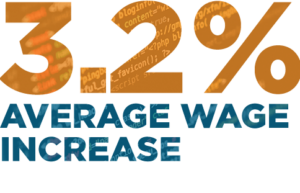 This is a typical increase in wages, only 0.1% higher than 2018, which implies stagnant wage growth.
However, job switchers in engineering can expect a 4.9% wage increase – a highly attractive reason to seek something new.
[vc_empty_space]
This is a typical increase in wages, only 0.1% higher than 2018, which implies stagnant wage growth.
However, job switchers in engineering can expect a 4.9% wage increase – a highly attractive reason to seek something new.
[vc_empty_space]
 25.7% of employees are actively seeking new job opportunities.
And 55.5% are passively open to new job opportunities.
25.7% of employees are actively seeking new job opportunities.
And 55.5% are passively open to new job opportunities.
Best cities for jobs
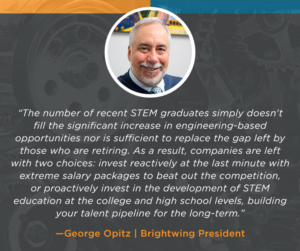 Glassdoor ranks these cities based on hiring opportunity, cost of living, and overall job satisfaction:
Glassdoor ranks these cities based on hiring opportunity, cost of living, and overall job satisfaction:
- Pittsburgh, PA
- St. Louis, MO
- Indianapolis, IN
- Cincinnati, OH
- Hartford, CT
- Boston, MA
- Memphis, TN
- Raleigh, NC
- Cleveland, OH
- Detroit, MI
Top Perks Employers are Highlighting
- Casual dress codes
- Employee discounts
- Remote work opportunities
- Extra paid time off
- Signing bonuses
- Free lunches
- Gym memberships
- Work from home Fridays
- Daycare
A New Focus for the Future of Hiring
In 2018, AI-powered recruitment technologies took off across every industry. Seeking to automate the application, screening, and interviewing processes, these tools unburden the hands and minds of recruiters and corporate talent acquisition professionals everywhere. However, our stance on this trend has been, and always will be, that humans are greater than machines – most especially in recruiting for highly skilled Technology, Finance, Engineering and Marketing professionals. Even with a quarter of employees looking for a new job, and over half passively interested should the opportunity present itself, employers cannot rely on the programming of their recruitment technology to make the right matches and entice the best-fit talent. This is the year that employers must focus on the human side of recruitment, specifically, the candidate experience. Here are a few numbers proving why the candidate experience is critical this year: 68% of employees believe the candidate experience is a reflection of the employee experience
68% of employees believe the candidate experience is a reflection of the employee experience
 51% of people continue to look for jobs even after they’ve accepted an offer
51% of people continue to look for jobs even after they’ve accepted an offer
 31% of candidates expect a customized message when a company reaches out with a new opportunity
31% of candidates expect a customized message when a company reaches out with a new opportunity
 55% of applicants give up if they haven’t heard back from a company within two weeks
In short, the role of the candidate experience in your recruitment process cannot be overlooked. One in seven new hires accept a job offer only to walk away at the last minute. Do not let this become your story.
55% of applicants give up if they haven’t heard back from a company within two weeks
In short, the role of the candidate experience in your recruitment process cannot be overlooked. One in seven new hires accept a job offer only to walk away at the last minute. Do not let this become your story.
Quick steps to an awesome candidate experience
- A fast and easy (and mobile-responsive) application process
- Quick feedback and responses to every candidate
- A compelling employer brand that reflects your company culture
- Personalized emails, phone calls, and messages throughout the process
- A short, but thorough, interview process
- A clear understanding of the benefits and perks you offer
- An efficient and valuable onboarding process
Hiring Insights in Engineering
Engineering employment has seen sustained growth over the last few years, up 2.27% in the last year alone. A majority of companies, 69%, anticipate hiring more engineers over the next 5-10 years.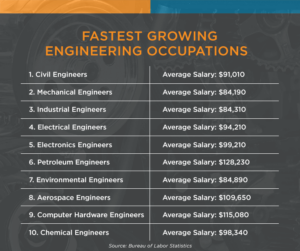
The Growing Engineering Talent Shortage
The demand is strong, but the level of engineering talent can’t keep pace. This is partly due to too few engineering graduates, as well as an increasing number of retirees. It’s a major concern; 98% of companies are all too aware of how their business can suffer if they can’t fill open engineering positions. Here are the top 5 biggest concerns with the engineering shortage:- Loss of competitiveness
- Inability to innovate
- Higher product development costs
- Lost revenue opportunities
- Poor design efficiency
|
|
|
2019 from the Perspective of Key Leaders
 “Low unemployment and increasing skills gaps continue to plague employers who are struggling to fill roles at all levels within their organizations,” said Matt Ferguson, CEO of CareerBuilder. “Fifty percent of U.S. employers reported that it is taking them longer to fill jobs today compared to any other period of time — a trend that is ultimately giving job seekers more leverage.”
“Low unemployment and increasing skills gaps continue to plague employers who are struggling to fill roles at all levels within their organizations,” said Matt Ferguson, CEO of CareerBuilder. “Fifty percent of U.S. employers reported that it is taking them longer to fill jobs today compared to any other period of time — a trend that is ultimately giving job seekers more leverage.”
How Are You Overcoming the Engineering Talent Shortage?
You’re probably gearing up for 2019 hiring, but some of these statistics might be concerning. For us, these statistics are eye-opening. We’re always looking for new ways to partner with companies to overcome these challenges. Our talent acquisition solutions are one-part relationships, one-part insight, and one-part results. It’s a recipe that works every time, and we’d love to introduce you.We want to partner with you. Let’s chat.
Share This Post [social-share] More Like ThisContents
- A Quick Glance at the 2019 Labor Market
- A New Focus for the Future of Hiring
- Hiring Insights in Information Technology
- 2019 from the Perspective of Key Leaders
A Glance at the 2019 Labor Market
 The national unemployment rate is at a record low since 1969 and is even lower in many industry sectors and regional markets.
The national unemployment rate is at a record low since 1969 and is even lower in many industry sectors and regional markets.
 This is a typical increase in wages, only 0.1% higher than 2018, which implies stagnant wage growth.
However, job switchers in tech can expect a 9.1% wage increase – a highly attractive reason to seek something new.
[vc_empty_space]
This is a typical increase in wages, only 0.1% higher than 2018, which implies stagnant wage growth.
However, job switchers in tech can expect a 9.1% wage increase – a highly attractive reason to seek something new.
[vc_empty_space]
 25.7% of employees are actively seeking new job opportunities.
And 55.5% are passively open to new job opportunities.
25.7% of employees are actively seeking new job opportunities.
And 55.5% are passively open to new job opportunities.
Best cities for jobs
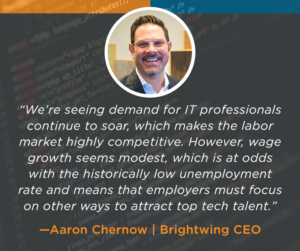 Glassdoor ranks these cities based on hiring opportunity, cost of living, and overall job satisfaction:
Glassdoor ranks these cities based on hiring opportunity, cost of living, and overall job satisfaction:
- Pittsburgh, PA
- St. Louis, MO
- Indianapolis, IN
- Cincinnati, OH
- Hartford, CT
- Boston, MA
- Memphis, TN
- Raleigh, NC
- Cleveland, OH
- Detroit, MI
Top Perks Employers are Highlighting
- Casual dress codes
- Employee discounts
- Remote work opportunities
- Extra paid time off
- Signing bonuses
- Free lunches
- Gym memberships
- Work from home Fridays
- Daycare
A New Focus for the Future of Hiring
In 2018, AI-powered recruitment technologies took off across every industry. Seeking to automate the application, screening, and interviewing processes, these tools unburden the hands and minds of recruiters and corporate talent acquisition professionals everywhere. However, our stance on this trend has been, and always will be, that humans are greater than machines – most especially in recruiting for highly skilled Technology, Finance, Engineering and Marketing professionals. Even with a quarter of employees looking for a new job, and over half passively interested should the opportunity present itself, employers cannot rely on the programming of their recruitment technology to make the right matches and entice the best-fit talent. This is the year that employers must focus on the human side of recruitment, specifically, the candidate experience. Here are a few numbers proving why the candidate experience is critical this year: 68% of employees believe the candidate experience is a reflection of the employee experience
68% of employees believe the candidate experience is a reflection of the employee experience
 51% of people continue to look for jobs even after they’ve accepted an offer
51% of people continue to look for jobs even after they’ve accepted an offer
 31% of candidates expect a customized message when a company reaches out with a new opportunity
31% of candidates expect a customized message when a company reaches out with a new opportunity
 55% of applicants give up if they haven’t heard back from a company within two weeks
In short, the role of the candidate experience in your recruitment process cannot be overlooked. One in seven new hires accept a job offer only to walk away at the last minute. Do not let this become your story.
55% of applicants give up if they haven’t heard back from a company within two weeks
In short, the role of the candidate experience in your recruitment process cannot be overlooked. One in seven new hires accept a job offer only to walk away at the last minute. Do not let this become your story.
Quick steps to an awesome candidate experience
- A fast and easy (and mobile-responsive) application process
- Quick feedback and responses to every candidate
- A compelling employer brand that reflects your company culture
- Personalized emails, phone calls, and messages throughout the process
- A short, but thorough, interview process
- A clear understanding of the benefits and perks you offer
- An efficient and valuable onboarding process
Hiring Insights in Information Technology
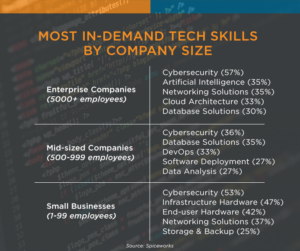 There is no surprise that the IT field continues to be one of the most competitive to recruit in. Unemployment remained under 2% for most of 2018, and 33% of organizations plan on increasing their IT staff in 2019. That is the recipe for a high-demand, low-supply IT marketplace.
There is no surprise that the IT field continues to be one of the most competitive to recruit in. Unemployment remained under 2% for most of 2018, and 33% of organizations plan on increasing their IT staff in 2019. That is the recipe for a high-demand, low-supply IT marketplace.
- Deficit of 4.3 million tech workers by 2030
- $449.7 billion unrealized revenue due to talent shortage
 62% are seeking a better salary
62% are seeking a better salary
 52% are seeking IT skill advancement
52% are seeking IT skill advancement
 36% are seeking better work-life balance
36% are seeking better work-life balance
 35% are seeking more prioritization of IT
35% are seeking more prioritization of IT
2019 from the Perspective of Key Leaders
 “Low unemployment and increasing skills gaps continue to plague employers who are struggling to fill roles at all levels within their organizations,” said Matt Ferguson, CEO of CareerBuilder. “Fifty percent of U.S. employers reported that it is taking them longer to fill jobs today compared to any other period of time — a trend that is ultimately giving job seekers more leverage.”
“Low unemployment and increasing skills gaps continue to plague employers who are struggling to fill roles at all levels within their organizations,” said Matt Ferguson, CEO of CareerBuilder. “Fifty percent of U.S. employers reported that it is taking them longer to fill jobs today compared to any other period of time — a trend that is ultimately giving job seekers more leverage.”
How Are You Overcoming the Tech Talent Shortage?
You’re probably gearing up for 2019 hiring, but some of these statistics might be concerning. For us, these statistics are eye-opening. We’re always looking for new ways to partner with companies to overcome these challenges. Our talent acquisition solutions are one-part relationships, one-part insight, and one-part results. It’s a recipe that works every time, and we’d love to introduce you.We want to partner with you. Let’s chat.
Share This Post [social-share] More Like ThisA candidate’s experience is impacted by who or what is driving the interaction. Let’s explore how recruiting chatbots impact it.
For jobseekers, AI tools deliver feedback faster than they otherwise might receive. For recruiters, the sheer volume of candidates these tools can screen is impressive.But can you trust AI-powered recruiting chatbots?
with unemployment rates at historic lows, the vast majority of .NET developers are gainfully employed. Attracting that talent requires a unique approach.
In Part 6 of our Real Stories from Real Recruiters series, see how one recruiter goes above and beyond to equip her candidates for success.


